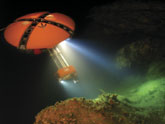Journey to the Center of the Earth

On his way to visit friends in upstate New York, David Wettergreen heads north on I-79 from Pittsburgh. While behind the wheel, he navigates through the minefield of potholes with little concern. And why not? When you're a professor at Carnegie Mellon's Robotics Institute and involved in a project that explores the mother of all potholes, what's a few interstate craters along the way?
"This one can swallow quite a few cars," Wettergreen says, referring to the Zacatón Cenote, a 100-meter-wide sink hole located on a jungle plateau near northern Mexico's Tamaulipas, a volcanic region pockmarked with numerous water-filled basins that offer no shoreline or lip. For anyone who hacks through the tangled brush of cacti and palms, sink holes can appear suddenly, as if out of nowhere.
What makes the Zacatón so enticing is the unknown. To date, there is no conclusive data of its depth, with estimates ranging as far down as 1,000 feet, which would make it the biggest sink hole in the world. To find out more about Zacatón, Carnegie Mellon has partnered with Stone Aerospace, the major contractor for NASA, in a $5 million, three-and-a-half year scientific project known as the Deep Phreatic Thermal Explorer (DEPTHX). The plan is to use an automated, tether-free underwater vehicle operating with technology that could be transferred to explore the surfaces and seas of other planets and moons in the future.
The seven-foot, 1.3-ton robot resembles a giant orange bicycle helmet complete with 36 onboard computers and 56 sonar sensors. It also possesses cameras; an onboard microscope to detect possible living cells; and an expandable appendage to gather samples of rock, water, and debris. Using Carnegie Mellon software, the submersible can work on its own for hours at a stretch, constructing three-dimensional maps of the sink hole's interior. It hugs the hole's sheer limestone walls, using specialized environmental sensors that allow it to float along at a safe distance.
Zacatón is mysterious, for the first 60 feet it drops straight down into warm water that lacks oxygen. "The water temperature is about 90 degrees," says Wettergreen, "which tells us there's some thermal source, but we don't know where." Could the region's sink holes be interconnected? Are they heated by volcanoes? Could there be life? To Wettergreen and the many geologists, biologists, and roboticists attached to the project, DEPTHX may provide the answers.



